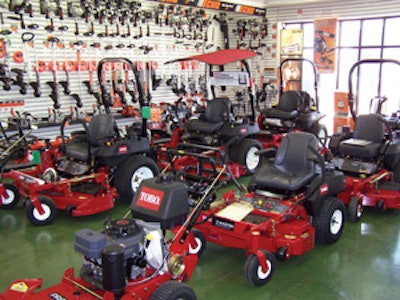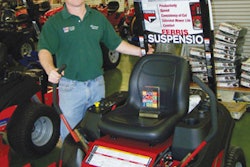
The size of your business isn't always the best measure of your success. However, if you want to seriously play in the wholegoods retail market, consultant Rick Barrera says you need a strategy to grow sales fast, while remaining lean and mean in the process.
When a dealership evolves from "small repair shop" to "growing dealership with an increased emphasis on equipment sales," managing for profitability becomes much more difficult. These mid-level (Tier 2) dealers often see a 3-5% jump in overhead. Expenses such as payroll, training, advertising, fuel, maintenance/repairs, office supplies and insurance often increase.
The interesting thing is, as the mid-level dealer grows sales and becomes a "large" dealer, his overhead often remains the same. He's simply making better use of his assets—and making more money in the process. That's why, Barrera explains, mid-level dealers need a strategy to rapidly grow sales while keeping their operating expenses in check. Otherwise, the chasm known as Tier 2 can be difficult to cross.
But it can be crossed. You just need to hunker down, focus and remain diligent. "There are a lot of things you can do to manage yourself through Tier 2," Barrera says.
"Don't think you have to do them all at once. Focus on one at a time as you rapidly work your way across the chasm."
Change focus from operations to revenue
The first thing you have to do is transform your way of thinking. Smaller, service-oriented dealers are typically more operations-focused. They're transfixed on the process of getting machines in the door, serviced and back out the door. They tend to see things more from their personal point of view.
Mid-level dealers, on the other hand, need to focus on revenue generation. "They need to really get customer-focused and start viewing their business through the customer's eyes," Barerra says.
Ask yourself:
• Where do my customers and potential customers live?
• How can I serve them?
• How do I reach out to them?
"Start making a name for yourself," advises Barerra, who happens to be a big fan of direct marketing. "Oversized postcards to specific zip codes are great. You can also make phone calls into those zip codes. You can really start to reach out in a very targeted way, and it doesn't cost that much."
Reaching out is even easier if your target is landscapers, which is an easily identifiable market. Look through the Yellow Pages. Pay attention to the trucks driving around your area. Develop a prospect list. Call these guys and set up appointments to go see them to learn what you can do to earn their business. Sometimes, all you have to do is ask for that business.
"A lot of times, landscapers haven't been feeling the love from their current dealer, especially when that dealer has been growing his customer base," Barerra points out. "You may have a chance to poach some business. Similarly, you can go after other commercial customers, such as golf courses, nurseries and municipalities."
In addition to direct marketing, Barerra says you should considering doing some special events. Again, identify who you want to target and tailor the event toward that customer. For example, incorporate more family fun events if you want to draw consumers. Put together some business sessions for landscapers. Municipal workers often enjoy safety and equipment maintenance clinics.
"Whatever you decide," Barerra reminds, "you have to start doing some aggressive marketing so you can cross the Tier 2 chasm as quickly as possible—preferably in a season or two."
Lean and mean
Challenging growth goals like that definitely require a revenue-focused mind-set. Still, it doesn't mean you can completely lose your focus on operations. As pointed out earlier, operating expenses typically rise 3-5% in Tier 2, which has a direct impact on your net profitability. Efficient operations become as important as ever in Tier 2. You just approach it from a different angle.
Your business, which has been built around people, should now be built around processes. For example, "Bill the parts counter guy" has always done things his way. That's fine; his way might be brilliant. Just get that process documented so it becomes the way that job or task is performed, regardless of who is performing it. Develop and document processes for everything you can think of—parts ordering, service writing, pricing and estimating, collections, etc.
Systems are important because 1) you need to delegate more so you can keep your focus on revenue generation, and 2) you need to run a lean and mean staff.
When your dealership grows to a Tier 2 level, you become a lot busier with more customers to deal with. The temptation is to add a bunch of staff. "You can't do that," Barerra warns. "Five employees is ideal; seven at the most if you're pushing well over $1 million a year." A general rule of thumb is $150K in sales per employee, though many leading dealers average a lot more than that.
Barerra offers the following glimpse of what an effective Tier 2 dealership staff might look like:
• The owner focuses on revenue generation: selling on the show floor and sometimes parts counter, visiting customers, handling the advertising, etc. The owner also works with suppliers and manages wholegoods inventory.
• The parts manager works the counter selling parts and accessories, manages parts inventory, manages the rental department and helps out on the show floor with equipment sales. This is why a more sales-oriented parts manager, as opposed to a technician-turned-parts manager, is often more effective for a growing Tier 2 dealership.
• One or two technicians stay on their benches generating billable hours.
• An administrator does the bookkeeping, along with IT-related functions like generating financial and inventory reports from your business system, managing your website, etc.
• A runner does deliveries, equipment set-ups, assists technicians, takes out the trash, etc. This is a good job for a high-school kid or retired person. You can always hire a couple part-timers to handle this important function.
Along with the desire to add staff, many growing dealers also want to add a bunch of new lines. Barrera says this is another temptation to resist. "Trying to be everything to everybody does not work," he adds. "Build your business around a single brand you believe in. Then supplement it with no more than one or two other lines."
Even if you are only carrying one unit from a manufacturer, it counts as a line. Barerra says, "Dealers love to cherry pick their favorite products from many manufacturers. This is deadly. It requires you to manage phone calls, visits, inventory, invoices, payments, credits, display space, POP, and many other time-consuming tasks for each vendor. You cannot afford this luxury in Tier 2. The narrower your lines, the faster you can cross Tier 2 profitably and get to Tier 3.
If you feel that you need to expand into other product categories—such as fun-karts or compact construction equipment to cover your slower times of the year—make sure the decision to add a new line or product category is preceded by thorough research so you know it's something your market needs and an investment you'll see a nice return on. Test the new line with a few units to ensure market acceptance and profitability before going whole hog. For many Tier 2 dealers, this kind of expansion is exactly the kind of distraction that isn't needed.
Also on the lean and mean side, Barerra says you should do zero-based budgeting. "Don't look at what you spent last year," he says. "Instead, ask yourself what the minimum amount you can spend is, without having a negative effect on productivity and customer service. Look at your phone bill, for instance. Do you really need three lines? Do you really need both a land line and a cell phone? On the other hand, you might need five to deliver great service, but you can lose that extra warehouse space if you consolidate your lines and get more efficient with your No. 1 line. Go through every line item in your budget and scrutinize everything."
Work the edges
You're actively seeking new customers to grow sales. You've trimmed all fat from your budget. Systems and processes have daily operations running smoothly, allowing you to keep your focus on revenue generation. "Now it's time to work the edges—identify the high-margin items and capitalize on them," Barerra says.
According to recent Yard & Garden State of the Dealer survey results, nearly 70% of Tier 2 dealers said parts/accessories account for 20-40% of total dealership revenue, with the average being 25%. The closer you can get to 40%, however, the better off you'll be.
"It helps when your revenue mix is skewed toward high-margin, high-velocity items," Barerra says. "Really push shovels, gloves, rakes, safety glasses and trimmer line. Look into products such as toys, flashlights, and even clothing like Carhartt. Don't run out and buy a pile right off the bat. Do some tests to see what will sell. If something does, buy a tad more next year."
Well-run used equipment and rental departments can also help you improve your overall gross margin. They key with rental is to have what your customers need—typically things like aerators, chippers, skid-steer attachments, trenchers, edgers—and keep them "utilized" in the field. "The key with used equipment," Barerra explains, "is to get it cheap and turn it fast."
In regards to new equipment sales, buy right and take advantage of supplier programs, especially longer terms. Don't tie up your money if you can use the suppliers' money. "However, your best deal is often the everyday low price; then turn that inventory," Barerra says. "You can also keep an eye out for your suppliers' slightly damaged and overstocked items. Talk to your customers to determine if you have a market for these products. Selling last year's models can also work, as long as the line didn't undergo some serious improvements or price changes." Your focus has to stay on revenue generation and margin. It is this magical pair that will be your bridge across the chasm.
There's a lot to think about when trying to cross the Tier 2 chasm, which is why it's gotten the best of many a dealer. Just remember that every Tier 3 was once a Tier 2. By shifting your focus from operations to revenue generation, keeping your dealership lean and mean, establishing systems and processes for everything, and capitalizing on your high-margin opportunities, you can ensure that you'll be the next dealer to make it across.
Three Tiers of Dealers
Tier 1 - Annual revenue below $750K
• Rarely more than half of total dealership revenue from wholegoods sales
• Roughly half of dealer population
Tier 2 - Annual revenue $750K-$1.5 million
• At least 55% of total revenue from wholegoods
• Roughly 20% of dealer population
Tier 3 - Annual revenue over $1.5 million
• At least 65% of total revenue from wholegoods
• Roughly 30% of dealer population
Based on data from recent Yard & Garden State of the Dealer surveys
About the Author
Rick Barrera is a nationally acclaimed speaker, marketing consultant and author known throughout the Fortune 500 for his extraordinary speaking ability and his unique approach to brand building. His client list includes Husqvarna, Abbott Labs, AutoZone, Bayer, Caterpillar, IBM, Intel, Merrill Lynch and Verizon. Rick's latest book, "Overpromise and Overdeliver: Using TouchPoint Branding to Design and Deliver Extraordinary Customer Experiences," has made both the Wall Street Journal and Business Week best seller lists. It is available online at www.Amazon.com or www.overpromise.com. If you register your book on Barrera's site you'll get access to even more ideas for growing your business.




















